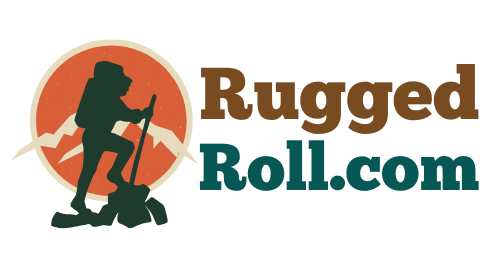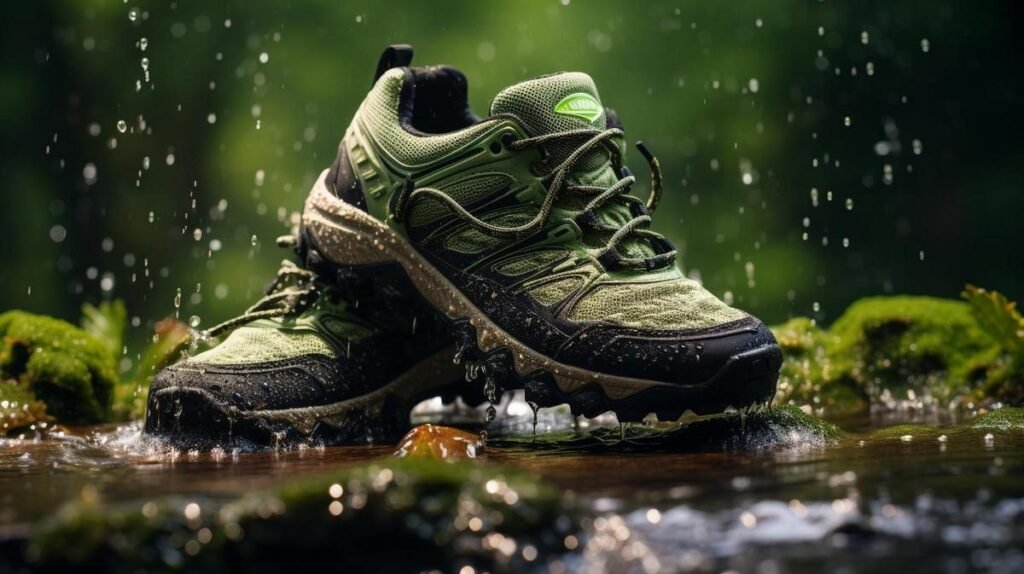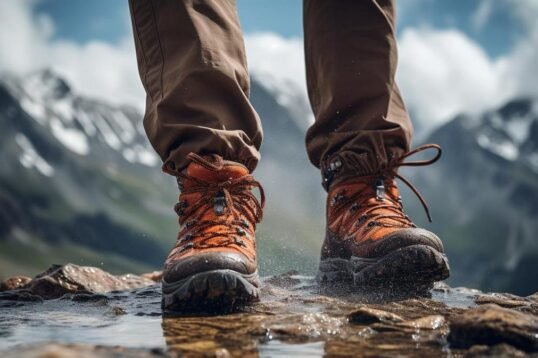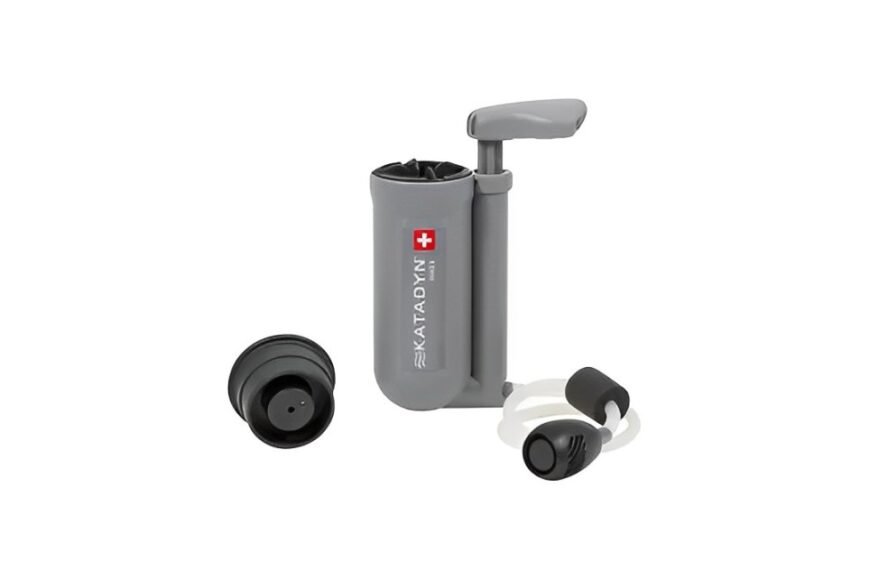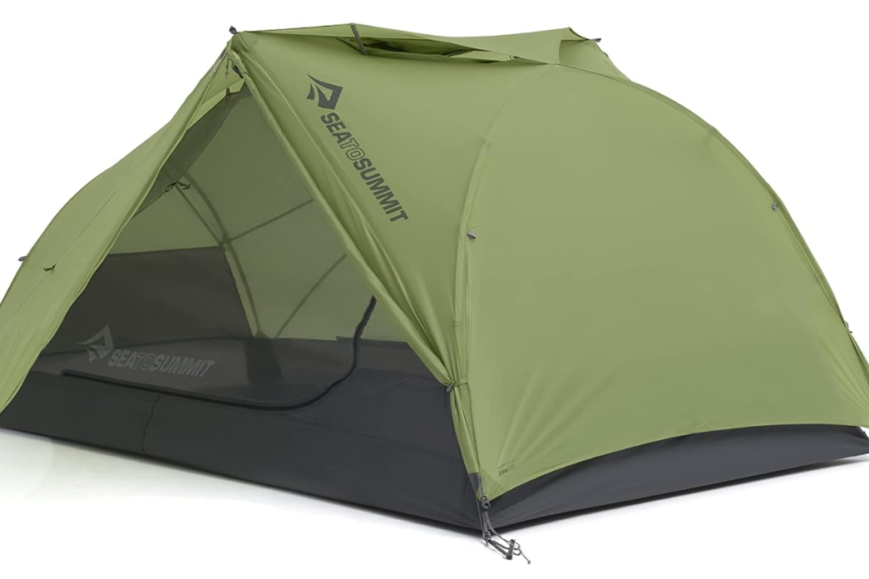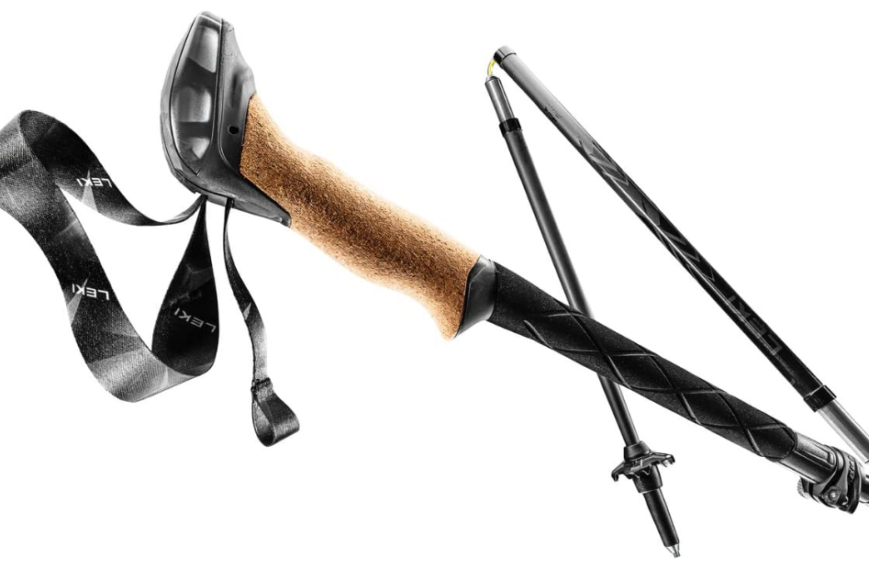- Waterproof hiking shoes use membranes like Gore-Tex to block water and allow airflow.
- Different builds for men’s and women’s shoes accommodate foot shape, load, and walking style.
- Breathable waterproof shoes keep feet dry and comfortable, crucial for long hikes.
- Lightweight waterproof shoes reduce foot fatigue, especially important for women.
- For wet conditions, select durable, water-resistant footwear with good traction and waterproof membranes.
- High-quality shoes like those from Merrell, Columbia, Keen, and Salomon offer durability, comfort, and a good grip.
- Waterproofing tech enhances outdoor experiences by keeping feet dry and improving comfort and grip.
- Multipurpose waterproof shoes can adapt to various terrains, with features suited for different conditions.
- In cold and snow, waterproof boots with insulation keep feet warm and dry.
- Added support in waterproof boots benefits ankle stability and foot comfort on uneven trails.
- Sustainable materials are increasingly used in creating eco-friendly, waterproof hiking footwear.
- Maintain waterproof hiking shoes by cleaning them, drying them properly, and applying waterproof treatments as needed.
- For beginners, waterproof hiking shoes are worth the investment for keeping feet dry and guarded against blisters, with budget-friendly options available.
Ever left the trail with soggy socks? Not cool. Waterproof hiking shoes claim to be the hero we all need, but do they live up to the hype? As an outdoor enthusiast at RuggedRoll.com, we know soggy feet can ruin a good hike. Let’s dig in and find which boots really keep you dry and your adventures high and dry.
What Makes Hiking Shoes Truly Waterproof?
Which hiking boots are most waterproof? The best kind uses special fabrics and tight seals to keep water out. My hikes have shown me that not all boots with the label “waterproof” work the same. So, let’s break it down and find out what truly makes a hiking shoe protect against water.
For a start, look for waterproof hiking shoes for women with a membrane. This hidden layer blocks water but lets air pass. Shoes with membranes like Gore-Tex, eVent, or others are top picks. They are often called the best women’s hiking boots for staying dry.
Materials are key too. Leather and some synthetics with waterproof treatments help a lot. They form the outer layer and work with the membrane to stop water. But they have to be treated well to keep doing their job.
Always check how boots are built. Good hiking boots with water protection have seams sealed from the inside. No sealed seams, no real waterproofing. Also, the design should cover your feet well. Low cuts might let water in over the top when you cross streams or face heavy rain.
It’s easy to get mixed up with water-resistant shoes. These can handle light rain but not a lot more. For real wet hikes, get waterproof hiking shoes. Water-resistant won’t cut it when the weather turns tough.
In short, picking the right hiking boots comes down to materials, how they’re built, and ensuring they have a waterproof membrane. With those boxes checked, your feet have the best chance to stay dry on wet trails.
How Do Men’s and Women’s Waterproof Hiking Shoes Differ?
Do men’s and women’s waterproof hiking shoes differ? Yes, they do. Men’s and women’s feet differ in shape and size, often needing different shoe designs. Men’s feet are typically broader, particularly at the heels and balls of the feet, and men’s shoes are often wider to match. Women’s waterproof trail shoes are made lighter and can fit more snugly, considering women’s generally narrower feet and lower body mass.
Men’s waterproof trail shoes are often designed to handle heavier loads, which can add to their weight. They are built to be tough with a focus on stability for rough terrain. In contrast, women’s lightweight waterproof boots aim to cut down on weight without giving up durability. This design characteristic helps to minimize foot fatigue, which can be vital on long trails.
There’s also a noticeable difference in style. Men’s shoes often come in dark and earthy tones, while women’s shoes may offer more variety in colors and patterns. Yet, both aim to blend style with function. They come with rugged soles for gripping the terrain and waterproof features for keeping feet dry.
Women’s shoes often have a softer cushioning, considering women’s lower weight and different walking styles caused by hip differences. Both types of shoes strive for a balance between comfort, durability, and weight.
Remember, the best waterproof footwear for trails depends on fit. It does not matter if a shoe is for men or women. What counts is how well it fits your foot and suits your hiking needs. Good fit leads to comfort, support, and, above all, dry and happy feet on your outdoor adventures.
Can Breathable Waterproof Hiking Boots Keep Your Feet Dry and Comfortable?
Yes, breathable waterproof hiking boots can keep your feet dry and comfy. They let air in, stop water, and handle moisture well. This is how you can enjoy long hikes without worrying about wet feet or blisters.
Breathable waterproof membranes are the secret sauce here. Gore-Tex, for example, is a big name in hiking footwear. It’s a thin layer found in many good waterproof hiking boot brands. It keeps water out but lets your foot’s sweat escape. This means your feet stay dry from inside and outside.
Hiking in the rain or crossing streams can test your boots. Yet, the right shoes will pass with flying colors. Gore-Tex and other membranes like it can handle this well. They stay airy even when the water’s all around. You need that balance between keeping water out and letting your feet breathe. When a shoe does both, your hikes are more pleasant, no matter the weather.
Look after your boots, and they’ll look after you. Keep them clean, and let them dry properly. Do this, and your breathable waterproof hiking boots will last many climbs and trails. They’re the right choice for any outdoor lover looking for superior water-resistant footwear. Choose wisely, treat them well, and your cozy, dry feet will thank you every step of the way.
What Are the Benefits of Lightweight Waterproof Boots for Hiking?
Lightweight waterproof hiking shoes for travel are key. They help you move with ease. You hike without heavy feet. Women’s waterproof boots for hiking must be light. This design cuts down on tired feet. You get less tired while you hike.
Light shoes are different from old, heavy hiking boots. Heavy boots can slow you down. They can make your legs tired fast. Light shoes keep you going. You can hike for more hours. Many say hiking feels better with light shoes.
Some women’s waterproof hiking shoe reviews agree. Lighter shoes help a lot on long trips. They say you don’t feel as worn out. Your hike feels more fun. You enjoy nature more.
When you pick your shoes, think light. Look at reviews for lightweight options. Think about your own needs. Remember, the right light shoe can make your hike a blast!
How to Choose the Best Waterproof Hiking Shoes for Wet Conditions?
Yes, you can wear hiking shoes in the rain. When choosing shoes for wet hiking conditions, look for durable water-resistant hiking footwear. Often, trail shoes with waterproof membranes work best. These keep water out but let feet breathe.
When it rains or the trails are wet, good traction keeps you safe. The sole’s durability matters, too. It should be tough enough to grip on muddy or slick surfaces. This stops you from slipping while walking.
To match your needs, assess the shoe’s waterproof level. Ask yourself where you plan to hike. Will there be light rain, or will you cross streams? Waterproof membranes in shoes help. Shoes built with these layers trap water on the outside. Yet, air still moves, and this keeps feet dry.
Different trails need different shoes. Flat paths are not like rocky ones. Choose shoes with strong water barriers for tough paths. For casual trails, lighter water-resistant shoes may be enough.
Remember, even the best shoe can’t always keep water out in deep water. But for rain and puddles, a quality pair of waterproof hiking shoes is key. They help you enjoy the hike without wet feet. Choose wisely for the trail ahead.
Why Opt for High-Quality Waterproof Shoes for Hiking Adventures?
When you hit the trails, top waterproof boots for trekking keep your feet dry. They outlast cheaper options, so you save money over time. Brands like Merrell and Columbia make high-quality men’s waterproof shoes for hiking. Women can trust brands like Keen and Salomon for premium waterproof hiking shoes.
These shoes use tough materials and strong build methods. They handle rough paths and wet weather well. Hikers who’ve worn them swear by their long-lasting quality. In online forums, many experienced hikers share stories of their quality shoes lasting for years. They also mention the higher upfront cost pays off as they avoid buying new pairs often.
Good shoes also give you a better grip on slippery surfaces. They keep your feet comfy on long hikes, preventing blisters. Whether you’re crossing streams or caught in a downpour, they’ve got you covered. Look for ones with waterproof labels and solid reviews. Shoes that work well for all genders are worth investing in. Remember, dry feet mean a better time outdoors, so choose wisely!
How Do Waterproof Technologies in Hiking Shoes Enhance Outdoor Experiences?
Imagine crossing a creek or hiking in the rain. Your feet stay dry! That’s thanks to the waterproof tech in your shoes. It’s magic for your feet, keeping them snug and dry, despite puddles or a downpour. Picture this: men’s hiking boots armed with waterproof technology that stops water in its tracks. How cool is that? Gore-Tex lined hiking boots go the extra mile, shielding your feet even in a storm.
Waterproofing tech matters a lot in hiking boots. It lets you explore without fear of soggy socks. Advanced water barrier hiking boots push the limits, turning away water like a superhero cape repels villains. Cutting-edge features in these boots include materials that let nothing through but still breathe so your feet don’t feel like they’re in a sauna.
This tech is not just about keeping water out. It also boosts your hiking game. With dry feet comes more comfort, and with comfort comes the urge to hike further. You can reach new peaks and trails with ease. Plus, these boots have a secret power: they help you stay on your feet by providing a better grip on wet or slippery surfaces. And get this: they could even make hiking more fun since you’re not worried about the next puddle.
Looking ahead, the future of waterproof hiking shoes looks bright. Expect even more amazing tech down the road. Innovations could include new materials that are lighter, more durable, and even more water-shy. Who’s ready to kiss wet socks goodbye? Raise your hand and get ready to step into a future where every puddle is a plaything, not a problem.
Is There a Waterproof Hiking Shoe Suitable for Every Terrain?
Yes, there are multipurpose waterproof hiking shoes designed for varied landscapes. They match specific terrains, such as mountains, forests, or deserts. When looking for all-terrain waterproof walking boots, focus on shoes that adapt to different grounds. These will have features like sturdy soles for grip and strong, water-repellant materials.
Let’s dig into how these boots work. Versatile water-repellant hiking boots can handle both rocky paths and muddy trails. This is because they have special soles that grip onto different surfaces. And the waterproof aspect is not just for rain. It also protects your feet from damp ground or walking through shallow streams.
Multifunctional waterproof shoes are worth it. They are perfect for hikers who explore all kinds of places. You want shoes that keep your feet dry on every adventure, right? That’s why it’s great to find a pair that suits every spot you go. These shoes should have waterproof features that work in each setting. They keep water out but still, let your feet breathe.
Case studies tell us hikers enjoy different places in one pair of boots. They stay comfy and dry, from deserts to snowy peaks. When you pick shoes, think about where you will hike most. Then, pick the ones that will perform best there. If you plan to hike in many settings, go for a shoe that is made for all kinds of land.
Remember, waterproof hiking shoes are key for a good hike. You can walk through nature and not get wet feet. Look for shoes that fit well, keep water out, and are right for where you’re headed. Good shoes turn a tough trail into a fun day out. They help you focus on the beauty around you, not on your wet socks!
How Do Waterproof Hiking Shoes Fare in Cold Weather and Snow?
Cold and snow test the best waterproof boots. They must keep their feet warm and dry. Insulated waterproof hiking footwear is key for cold hikes. Good boots pair insulation with a solid waterproof feature. This makes them snowproof too. But not all boots are the same. For top warmth and dryness, look for top options in both areas.
When you hike in the snow, follow some simple best practices. Make sure your waterproof shoes are also built for cold weather. Some boots are just for rain, not for snow. Footwear for winter hikes should have extra protection. This helps in tougher challenges like ice and deep snowdrifts.
You also need to think about how to keep the heat in. This is where insulation comes in. It traps heat close to your foot. This makes even extreme cold a little less biting. By choosing footwear that is both insulated and waterproof, you tackle two issues with one solution.
Remember, not all cold-weather hiking boots are the same. Some have more insulation or a better waterproof system. Always check before buying. Look for boots that hikers say are best for snow and cold. This way, you can be sure your feet stay warm and dry on your winter adventure.
What Are the Advantages of Waterproof Hiking Boots with Added Support?
Waterproof boots help keep feet dry. But when these boots have added support, they do much more. They help ankles stay strong on tricky trails. For women’s waterproof supportive hiking shoes, this means less risk of twists. Men’s mid-cut waterproof hiking boots go even higher up the ankle. This kind of boot gives more hold and safety on steep climbs.
We want shoes that feel good all day. That’s where extra cushioning comes in. It makes each step softer on your feet. It’s like walking on tiny pillows. Cushioned waterproof hiking boots can help prevent sore feet after a long day on the trails.
Not all hiking shoes are the same. Some have a tough sole that grips the ground well. Others have sturdy sides that protect your feet from sharp sticks and stones. These features keep your feet safe and comfy. They let you enjoy your hike without worry.
Every good hike needs the right gear. The right waterproof shoes can change a good hike into a great one. They help you move with ease and keep your feet in top shape. Whether it’s women’s or men’s boots, make sure they have the support you need. This way, you can take on any trail with confidence.
Can Sustainable Materials Be Used in Waterproof Hiking Footwear?
Yes, they can use plant-based and recycled materials in waterproof boots. Eco-friendly options in waterproof hiking shoes are on the rise. Brands now make sustainable waterproof hiking boots. They also make vegan waterproof walking boots.
These boots help the planet and keep your feet dry. They use less water and cut down on waste. This protects rivers and forests where we love to hike. Some of the materials they use include recycled rubber and plant-based fibers. These sources renew and don’t harm the earth.
Brands leading in sustainable hiking gear show that you can have both: durable boots and care for the environment. They use clever designs. They combine tough, sustainable materials with waterproof tech. This way, your feet stay dry, and the boots last a long time.
When they make eco-friendly boots, they think about the weather too. The boots must handle rain and puddles. They make sure the sustainable parts work just as well as other materials. The goal is to balance being kind to nature with making sure you enjoy your hike. No matter the weather.
Next time you shop for hiking gear, look for these green options. You can look cool, feel good, and do good all at once. Choose brands that care about outdoor spaces as much as you do. They take extra steps to ensure their work does not hurt our wild places. They work hard to keep our future hikes just as fun and beautiful.
How Do You Properly Maintain and Care for Waterproof Hiking Shoes?
Can I waterproof my Merrell hiking shoes? Yes, you can. First off, keep them clean. After each hike, remove dirt with a brush. Then, wipe the shoes with a damp cloth.
For storage, keep shoes in a cool, dry place. Avoid direct heat. This helps the shoes last longer.
If your shoes get wet, stuff them with newspaper. This helps them dry and keep their shape. Change the paper if it gets too wet.
For extra protection, consider DIY waterproofing. Use sprays or waxes made for hiking boots. Make sure they match your shoes’ material.
Over time, shoes might lose their waterproof edge. Check them for signs of wear. You can often fix small tears or reapply a waterproof layer.
Remember, the key is regular care. This way, your shoes stay ready for any adventure. Reliable materials and a bit of effort can make even old boots resist water.
To sum up, here’s what to do:
- Clean them after each use.
- Store them right.
- Stuff with newspaper when wet.
- DIY waterproof when needed.
- Fix small damages quickly.
Do this, and your trusty boots will serve you well in your outdoor ventures.
Are Waterproof Hiking Shoes a Good Investment for Hiking Beginners?
New hikers need waterproof shoes. They keep feet dry and help avoid blisters. Dry feet mean happy hikers.
Let’s find shoes that don’t break the bank. Look for budget-friendly waterproof hiking options. This way, you can test the trails without spending too much.
When you select your first pair, focus on essential features. A good grip is a must. So is comfort. Make sure they fit well.
Remember, cost-effective waterproof hiking options are out there. You don’t have to spend a lot for dry feet. Now, go enjoy those trails with confidence!
Conclusion
We’ve talked about how to keep your feet dry and happy on trails. Smart waterproof tech keeps your adventure going, rain or shine. Light, comfy shoes mean less tired feet. High-quality, durable gear is worth your bucks for long treks. Always match your shoe to your track for top safety. Care for your boots well, and they’ll stand by you on many hikes. Whether you’re new or a pro hiker, the right waterproof shoes will take you farther. Keep exploring, and let your gear boost your journey.
![]()
